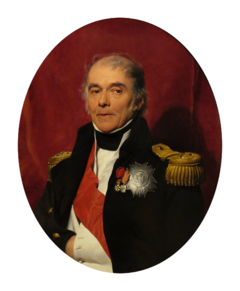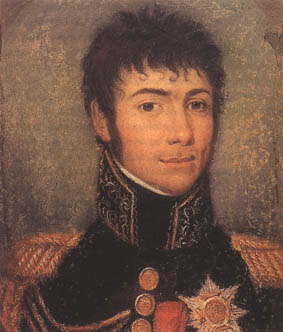Henri Gatien Bertrand facts for kids
Quick facts for kids
Count of the Empire
Henri-Gatien, comte Bertrand
|
|
|---|---|

Portrait by Delaroche, c. 1844
|
|
| Born | 28 March 1773 Châteauroux, France |
| Died | 31 January 1844 (aged 70) Châteauroux, France |
| Allegiance | |
| Years of service | 1793-1815 |
| Rank | Général de Division |
| Commands held | IV Corps Grand Marshal of the Palace |
| Battles/wars | French Revolutionary Wars |
| Awards | Name engraved on the Arc de Triomphe Grand Eagle of the Legion of Honour Count of the Empire |
| Other work | Deputy of Indre Commander of the École Polytechnique |
Henri-Gatien Bertrand (28 March 1773 – 31 January 1844) was a French general. He served during the French Revolutionary Wars and the Napoleonic Wars. He was very close to Napoleon Bonaparte. Bertrand was the head of Napoleon's personal staff, called the Grand Marshal of the Palace. He stayed loyal to Napoleon, even following him into exile on the islands of Elba and Saint-Helena.
Contents
Life of a Loyal General
Early Career and Rise
Henri-Gatien Bertrand was born in Châteauroux, France. His family was well-off. He finished his studies just as the French Revolution began. He then joined the army as a volunteer.
During a military trip to Egypt, Napoleon noticed Bertrand. Napoleon promoted him to colonel in 1798. After the important Battle of Austerlitz, Bertrand became Napoleon's aide-de-camp. This meant he was a personal assistant to the Emperor.
Close to the Emperor
Bertrand's life became very connected to Napoleon's. Napoleon trusted him completely. In 1808, Napoleon gave him the title of Count. By 1813, Bertrand became the Grand Marshal of the Palace. This was a very important job, as he was in charge of Napoleon's entire household.
In 1808, Bertrand married Fanny Dillon. She was a cousin of Empress Joséphine, Napoleon's wife. They had six children together. Two of their children were born while they were in exile with Napoleon.
Key Military Actions
Bertrand was a skilled engineer. In 1809, he led the building of bridges that helped the French army cross the Danube River during the Battle of Wagram.
In 1811, Napoleon made Bertrand the governor of the Illyrian Provinces. This was a region that France controlled at the time. During the 1813 campaign in Germany, Bertrand commanded a large group of soldiers called the IV Corps. He led them in battles like Leipzig. After the Battle of Leipzig, Bertrand's quick thinking helped save the French army from being completely destroyed.
Exile and Return
Bertrand showed incredible loyalty to Napoleon. He went with the Emperor to Elba in 1814 when Napoleon was first exiled. He also returned with Napoleon in 1815 for the "Hundred Days" campaign. Bertrand fought in the Battle of Waterloo alongside Napoleon.
After Napoleon's final defeat, Bertrand again chose to follow him into exile. He went with Napoleon to the distant island of St Helena. He stayed there until Napoleon's death.
When Bertrand finally returned to France, the new king, Louis XVIII, allowed him to keep his military rank. Bertrand later became a politician, serving as a deputy in 1830.
In 1840, Bertrand was chosen for a special mission. He traveled with Prince de Joinville to St. Helena. Their goal was to bring Napoleon's remains back to France. This event was known as the retour des cendres (return of the ashes).
Later Life and Legacy
During his time on St. Helena, Bertrand wrote down many of Napoleon's thoughts and conversations. This collection of writings was called "Les cahiers de Sainte Hélène."
Bertrand died in Châteauroux on January 31, 1844. He was buried in Les Invalides in Paris, a famous military burial site. He is mentioned in well-known books like The Count of Monte Cristo by Alexandre Dumas and Les Misérables by Victor Hugo.


